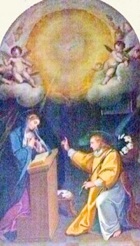

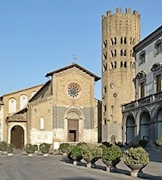
The first church here seems to have built soon after the return of the people of Orvieto from exile in Bolsena. Steps in the right aisle lead down to the excavationed area under Sant’ Andrea, which is open by appointment. The remains of the paleochristian church were discovered here in 1926 when the floor of its 11th century replacement collapsed. The excavations here have also uncovered the remains of much older structures that suggest that this site was at the heart of the Etruscan city.
An inscription that was recorded over the door to the sacristy claimed that Pope Benedict VIII consecrated the “new” church of Sant’ Andrea in 1013, although it was probably rebuilt in the 12th century.
Important civic occasions were held in Piazza di Sant’ Andrea in front of the church in the 12th century. These included the earliest documented submission to the Commune by one of the local nobles: Count Ranieri di Montoro who owned lands near Bolsena, made his submission here in 1168. What was probably the first civic palace was built next to Sant’ Andrea (on the site of the present Palazzo Comunale) in 1216-9.
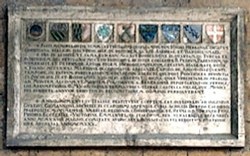
A plaque under the portico along the side of the church (in Corso Cavour) records the continuing civic importance of the church throughout the 13th century:
-
✴Pope Innocent III announced the Fourth Crusade here in 1216;
-
✴Pope Honorius III “canonised” St Peter Parenzo and crowned Peter II of Courtenay as the Emperor of Constantinople here in 1217; and
-
✴Pope Martin IV was crowned here in the presence of King Charles I of Naples in 1281.
It adds that Pope Nicholas IV and Pope Boniface VIII each celebrated the feast of the Assumption of the Virgin here in the 13th century.
An adjacent church of San Bartolomeo was documented in 1292 and again in 1350. It was subsequently demolished, at which point Sant’ Andrea became SS Andrea e Bartolomeo.
A college of canons was established here in 1300.
When a venerated wooden statue of the Virgin in the Duomo was credited by saving Orvieto from a prolonged siege in 1387-8, and the Commune celebrated by ordering that it should be taken in procession from the Duomo to Sant’ Andrea on the Feast of the Assumption, to be returned in another procession on the following day. The tradition has been maintained and the Cappella Nuova was commissioned to house the statue in 1396. The procession still takes place to this day, albeit that the statue has been lost (see below).
The facade of the church was rebuilt in 1487. The church suffered some form of catastrophic collapse in 1512 and had to be rebuilt. The adjacent campanile partially collapsed in 1514. The church suffered another collapse in 1926: as noted above, a paleochristian church was discovered underneath when the floor fell in. The church and campanile were restored in 1926-8 (see below) and, most recently, in 1992.
Exterior
The tower (12th century) to the right of the façade, which was probably originally the Torre Civica, was adapted in 1216-20 to form the campanile of the church. It collapsed in 1514 and was presumably rebuilt thereafter. Unfortunately, the campanile was over-restored in 1926-30 by Gustavo Giovannoni to a design based on that of the campanile (1103) of the Abbazia di Santi Severo e Martirio.
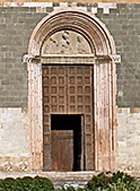
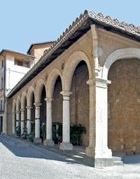
Interior
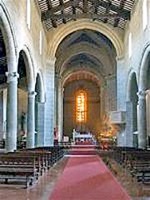
Colonnades of five granite columns separate the nave from the side aisles. These columns, which seem to have been re-used from a much older building, were recovered from the rubbly after the collapse of 1512, and their capitals were replaced. The nave has a wooden roof. The transept (which is two bays deep) and the apse are vaulted, and their ceilings are frescoed with starry skies.
An arch in the first two bays of the left aisle (which can also be seen on the external wall under the portico) indicates that where was a communicating space to the left of the church that was perhaps the church of San Bartolomeo mentioned above.
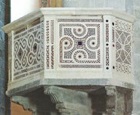
A venerated statue of the Madonna that is carried in procession through Orvieto on the Feast of the Assumption is housed in the central bay of a Gothic tabernacle on the right wall of the left transept. This is the replacement of the statue used when the tradition was inaugurated in 1388 (see above).
Monument of the Magalotti family (early 14th century)
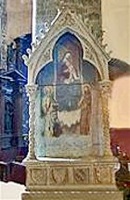
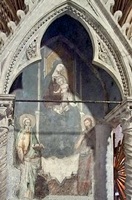
This monument on the composite column that stands in the middle of the right transept is by a follower of Arnolfo di Cambio. It is assembled under a Gothic tabernacle that was probably inspired by Arnolfo's monument to Cardinal de Bray (ca. 1282) in San Domenico.
Unfortunately, all the other sculpted components of the monument have been lost. The lower part of the fresco (ca. 1350) of the Madonna and Child with SS Peter and Paul is damaged where it abutted a sarcophagus.
The many coats of arms on the monument seem to be those of the Magalotti family, although early guides sometimes refer to the Monaldeschi del Cane. [Who were the Magalotti family ???]
Madonna and Child (ca. 1300?)
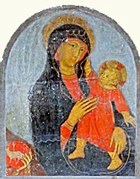
Madonna and Child with saints (late 14th century)
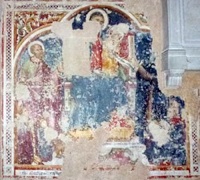
This damaged fresco in second bay of the left transept is attributed to Pietro di Puccio. It depicts Madonna and Child with SS Antony Abbot and Mark and a donor.
St James (probably 15th century)
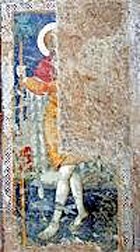
Frescoes on the left wall (15th century)
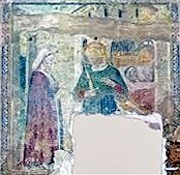
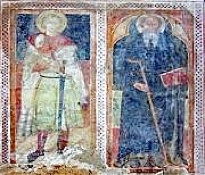
These frescoes in the 4th bay of the left wall depict:
-
✴St Julian after he murdered his parents; and
-
✴SS George and Antony Abbot.
Frescoes in Left Transept (15th century)
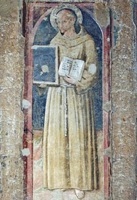
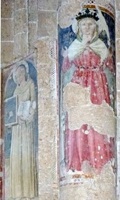
The frescoes on the middle column of the left transept depict:
-
✴St Bernardino of Siena, attributed to Pietro di Nicola Baroni; and
-
✴the Madonna delle Grazie.
Altarpieces attributed to Cesare Nebbia
-
✴the Annunciation (1586), in the first bay of the left transept, which came from the high altar of the Chiesa dell’ Annunziata (illustrated here); and
-
✴the Assumption of the Virgin (16th century), in the presbytery (which is sometimes alternatively attributed to Angelo Righi).
Pieta (16th century)
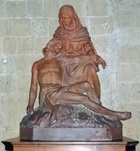
Christ in glory with saints (1713-4)
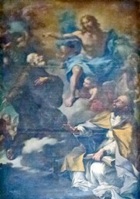
Remains from the Church
Paleochristian Reliefs (perhaps 9th century)
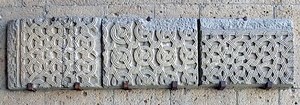
These reliefs, which probably came from Sant’ Andrea, are now in the loggia of Palazzo Soliano.
Read more:
Two articles particularly relevant to Sant’ Andrea are included in:
G. della Fina and C. Fratini (Eds), “Storia di Orvieto: Medioevo”, (2007) Pisa:
D. Scortecci, “Orvieto nell’ Alto Medioevo”, pp. 259-66; and
R. Pardi, “Edifici Monumentali ad Orvieto nel Medioevo”, pp. 296-8
Architectural fragments in the excavation area are described, dated and illustrated in:
D. Scortecci, “La diocesi di Orvieto ” (2003) Spoleto
Return to Monuments of Orvieto.
Return to Walk II.
